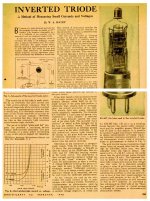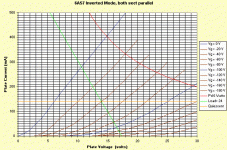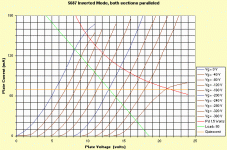I've been using Electronic Workbench software since its inception about 25 yrs ago.
EWB was developed right here in Toronto 'The Big Smoke' & sold to NI around 2005.
So EWB was born long after the heyday of tubes, it has no pentodes. And I could find
no way to load a pentode file. But there is a triode whose parameters can be set.
I had some ideas & here is how it evolved, written up much later.
It depends on the Inverted Triode concept somewhat to complete the puzzle.
Complete with actual measurements on the bench, a lot more than just talk. 🙂
EWB was developed right here in Toronto 'The Big Smoke' & sold to NI around 2005.
So EWB was born long after the heyday of tubes, it has no pentodes. And I could find
no way to load a pentode file. But there is a triode whose parameters can be set.
I had some ideas & here is how it evolved, written up much later.
It depends on the Inverted Triode concept somewhat to complete the puzzle.
Complete with actual measurements on the bench, a lot more than just talk. 🙂
Attachments
For the curious & others, more on Inverted Triode applications.
The inverted triode grid-plate curves are from the work of Steve Bench,
part of his look at grids driving the load, While the plates input the audio.
I tried the link today, it still works-
http://diyaudioprojects.com/mirror/members.aol.com/sbench101/
The inverted triode grid-plate curves are from the work of Steve Bench,
part of his look at grids driving the load, While the plates input the audio.
I tried the link today, it still works-
http://diyaudioprojects.com/mirror/members.aol.com/sbench101/
Attachments
After reading Stevie Bench's article, I built a headphone amplifier with inverted triodes in the output. It sounds great - my best effort so far for headphone amplifiers. But, it is a real beast with chokes and double power supply.For the curious & others, more on Inverted Triode applications.
The inverted triode grid-plate curves are from the work of Steve Bench,
part of his look at grids driving the load, While the plates input the audio.
I tried the link today, it still works-
http://diyaudioprojects.com/mirror/members.aol.com/sbench101/
Similar circuit has been reported in Terman's book to build UHF oscillators. Input at plate, output at grid. My doubth is the efficiency of it at audio services. Grids cannot manage large power until melt themselves.
Put the inverted Triode in the N Fdbk path of a high power Pentode/Beamer or Mosfet to get a high power Triode output. ( Inverted triode grid grounded, or signal input there, with output from CCS loaded cathode to the pentode grid. Some extra attenuation may be useful at the Inverted Triode plate input from the Pentode output.)
Last edited:


